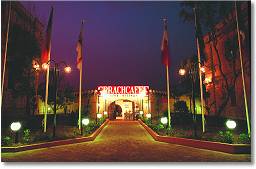|
||||||
| Towns and villages | |
|
Valletta
The Fortress City, Citta' Umilissima, "a city built by gentlemen for gentlemen". Valletta has many titles, all recalling its rich historical past. It is the "modern" city built by the Knights of St John; a masterpiece of the baroque; a European Art City; and a World Heritage City. But these are just some of its faces and fortunes. |
|
|
Valletta is also Malta's capital city: a living, working city, the administrative and commercial heart of the Islands. Nowhere in Malta is the life of the Islands reflected more than here. The city is busy by day, yet retains a timeless atmosphere. The grid of narrow streets house some of Europe's finest art works, churches and palaces.
Valletta hosts a vast cultural programme. Street events are staged against the city's magnificent baroque architecture and floodlit bastions. There is theatre and music and all manner of things to see and join in, from avant garde art to traditional church festas. The city is a delight to shop in: narrow side streets are full of tiny shops selling antiques, maps, books, prints and jewellery.
Walking around Valletta, you'll come across an intriguing historical site around every corner: votive statues, niches, fountains and coats of arms high up on parapets. And when you need to stop and take it all in, the city yields up squares, courtyards, gardens and any number of cafés, right on cue.
The Three Cities
The Three Cities offer an intriguing insight into Malta and its history. Left largely unvisited, the Three Cities are a slice of authentic life, and a glimpse into Malta’s maritime fortunes.
The Three Cities can rightly claim to be the cradle of Maltese history. Vittoriosa and Senglea on rocky promontories jutting into Grand Harbour, and Cospicua at the end of the creek between, have provided a home and fortress to almost every people who settled here.
Their harbour inlets have been in use since Phoenician times: the docks always providing a living for local people, but also leaving them vulnerable when Malta’s rulers were at war. As the first home to the Knights of St John, the Cities’ palaces, churches, forts and bastions are far older than Valletta’s.
The local communities here celebrate holy days and festas as nowhere else on the Islands. The most spectacular events are the Easter processions when statues of the "Risen Christ" are carried at a run through crowded streets. Another attraction is the Birgu Festival in October which re-enacts the arrival of the Knights on Malta in 1530.
Although renamed by the Knights to reflect their victory over the Ottoman Turks, the Cities are still called by their older names of Birgu, L’Isla and Bormla. They are known as the ‘Cottonera’ after the Grand Master Cottonerwho built their inland defences. Understanding this name game is all part of discovering a fascinating area of the Islands.
The Island’s villages
Worlds apart from the main resorts and the capital Valletta, are the Islands’ villages. They are the epitomé of Mediterranean life. The soul of the Islands’ past. Yet with their lively festas and unique everyday life they are very much part of the Islands’ culture today.
Even the smallest has its own baroque wonder, the parish church. And to locals, each village has its unique character. After visiting a few, you’ll soon pick up on the differences.
Some are known for their festas and traditions, others are national gems as they house archaeological or architectural treasures. Then there are the seaside villages, where the rhythm of life is dictated by fishing. While life in inland villages is determined by the harvesting of the various fruits and vegetables grown nearby.
The oddity about the Islands’ villages is their size. A village is not defined by the number of residents or streets. The description really dates back to a time when village boundaries were defined by parishes. Some of the larger ones, like Zebbug in central Malta are still referred to as villages.
Malta also has its ‘Three Villages’, rather like its Three Cities of Vittoriosa, Cospicua and Senglea. The Three Villages are Attard, Balzan and Lija in central Malta. During the Golden Age of Malta after the Great Siege, many noble families built houses here, and identified the villages with a semi-urban sophistication. |
|

